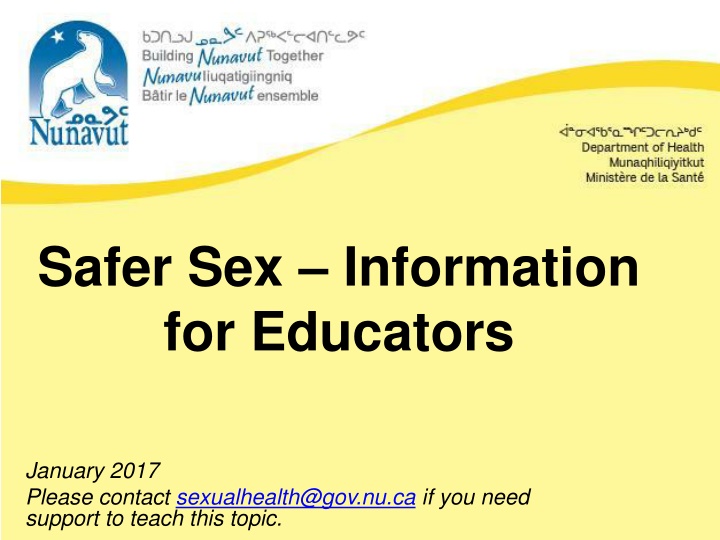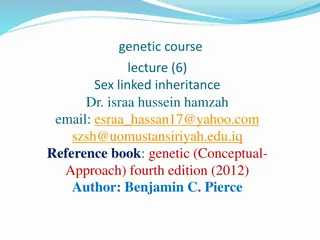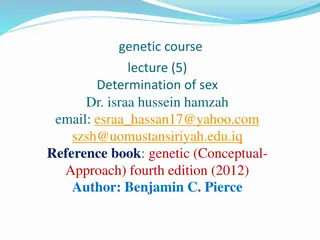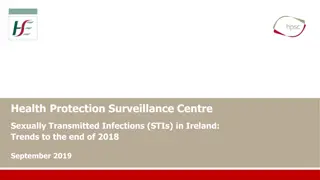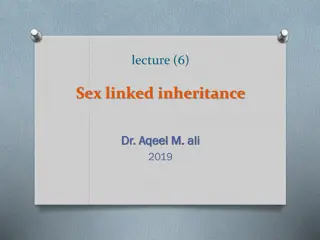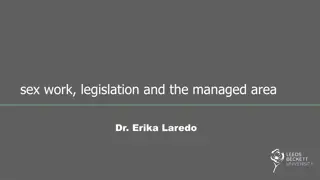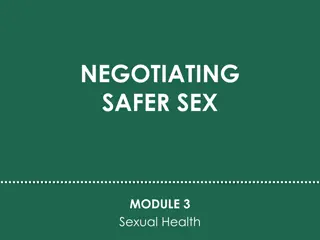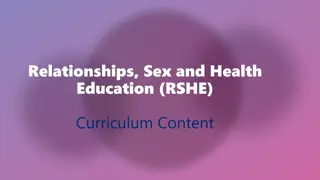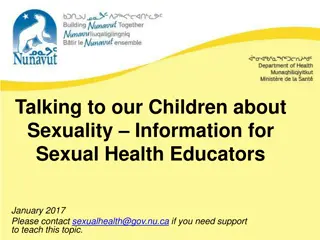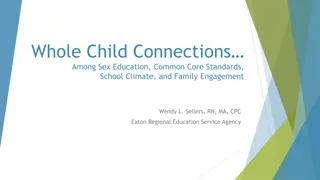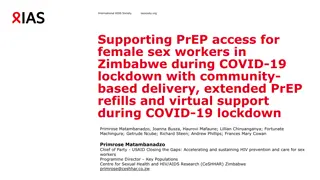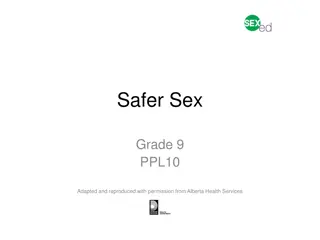Safer Sex Information for Educators - Nunavut Resources and Key Messages
Comprehensive resource guide for educators on teaching safer sex practices, focusing on sexually transmitted infections (STIs), prevention methods like condom use and testing, and key messages regarding the importance of STI awareness and treatment. Includes links to Nunavut-specific resources and practical tips on using the material in various educational and community settings.
Uploaded on Oct 03, 2024 | 0 Views
Download Presentation

Please find below an Image/Link to download the presentation.
The content on the website is provided AS IS for your information and personal use only. It may not be sold, licensed, or shared on other websites without obtaining consent from the author.If you encounter any issues during the download, it is possible that the publisher has removed the file from their server.
You are allowed to download the files provided on this website for personal or commercial use, subject to the condition that they are used lawfully. All files are the property of their respective owners.
The content on the website is provided AS IS for your information and personal use only. It may not be sold, licensed, or shared on other websites without obtaining consent from the author.
E N D
Presentation Transcript
Safer Sex Information for Educators January 2017 Please contact sexualhealth@gov.nu.ca if you need support to teach this topic.
Nunavut-Specific Resources for Teaching Safer Sex Available at: www.irespectmyself.ca, from local CHR, or by contacting sexualhealth@gov.nu.ca
Where to use this resource Presentations to youth (school, youth groups, etc) Presentations to CPNP groups Leave a pile of these anywhere you dispense condoms As a take-home resource from well- woman, prenatal, or well-man checks As a give away or prize at health fairs or store booths
Key Messages Sexually transmitted infections (STIs) can cause cancer, heart problems, infertility (can t get pregnant) and even death if not treated. They can harm babies if mothers are infected while pregnant. Most STIs can be cured with medicine. Those that can t be cured can be treated! Most people with STIs don t have symptoms. If you get tested and treated, make sure your partner(s) also get tested and treated before you have sex with them again.
STIs: The Basics STIs can be passed between two people if there is contact between a vagina, penis, anus, mouth, or hand or object that has touched any of these areas Most people with STIs don t have any symptoms. Some people have a rash, feel unwell, or have discharge from the penis, vagina, or anus. People without symptoms can still pass STIs to others!
Safety Under The Sheets Three steps for STI protection Wear a condom Get tested Get treated
When should sexually active people get tested for STIs? If they have symptoms Before having sex with a new partner Every 3-6 months if they OR their partner are having sex with anyone else Get tested even if they use condoms!
Condoms 101 Lube helps reduce the risk of STIs and can improve pleasure while using condoms. Condoms that have frozen might be more likely to break keep them inside!
STI Testing Step By Step Possible activity: field trip or open house at health centre to de-mystify STI testing Ask for a well-woman or well- man check if shy Young people don t need permission from their parents/ guardians for STI testing and treatment
Talking to your Partner Healthy sexuality is also about communication, relationships, and respect Have sex when you feel ready (remember that having sex is not always a choice for everyone) Talk to your partner before you have sex Many types of relationships are normal
Your Partner Says/ You Say Addresses some of the common objections people have to using condoms Activity: brainstorm objections people have to using condoms. Then ask participants how they could respond.
Choices Available in all schools in Nunavut: graphic novel, lesson plans, and DVD Approved by Dept of Education for Grade 7-9 Aulajaaqtut Themes: sexual health, decision making, peer pressure, healthy relationships, communication, accessing health care
Sexual Exposure Chart For every partner someone has sex with, it s like they are also having sex with everyone that person had sex with
Extra note for educators regarding age of consent for STI testing/ treatment and birth control: Anyone, of any age, can come to the health centre for STI testing/ treatment and birth control. If the person is young, the nurse may ask a few extra questions to be sure that the person is not being sexually abused and to be sure that the person understands the benefits and risks of treatment.
Our role as sexuality educators Build our participants Knowledge Skills Confidence How can we do this?
Best Ways to Teach Find out what they already know Make them feel good about themselves recognize success! Make it relevant to their life Focus on good things not just fear Humour get the giggles out Drama/ Role Play Telling stories Yell out words to get comfortable saying them Arts and crafts Songs Radio and TV script writing Videos Activities and games Debates Expert groups have them teach themselves! Storytelling Hands-on Pictures Guest speakers Field trips Question box Ask questions to check participant s understanding
Activities for Teaching about Safer Sex Think-Pair-Share Gallery Walk Role Play True/False Expert Groups BINGO Storytelling stories, poems, songs Condom balloons Debates Guest speakers Field trips to the health centre Games for Adolescent Reproductive Health - http://www.iwtc.org/ideas/10_games.pdf
Tips for educators teaching sexual health Be honest, open, and welcoming Keep your sense of humour Don t worry if the conversation isn t perfect Use TV shows, music, movies, the news, and real life to start a conversation.
People wont remember what you said or what you did. They will remember how you made them feel.
Consider Asking a respected Elder to come in and speak about the topic to share traditional knowledge and values. Meet with the Elder in advance to discuss the topic and ensure appropriate, inclusive, and respectful sharing of knowledge. Consider whether there is any potential for hurt or harm in the information being shared. After the Elder leaves, have a discussion with your group about similarities and differences between traditional and modern knowledge. Be prepared to answer questions with objective, factual, and up-to- date information.
Please review Teaching Sexual Health Background Information for Educators at www.irespectmyself.ca. Please check out the STIs and Safer Sex Classroom Presentation and Lesson Plan at www.irespectmyself.ca. Want more information about safer sex? http://www.irespectmyself.ca/en/having-sex/protect- yourself/safer-sex http://www.sexandu.ca/stis/ http://www.ippf.org/sites/default/files/2016- 10/Putting%20Sexuality%20back%20into%20Comprehensive%20Se xuality%20Education_0.pdf
